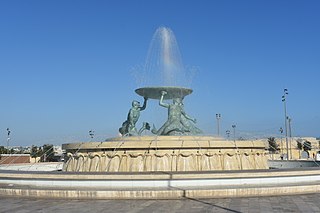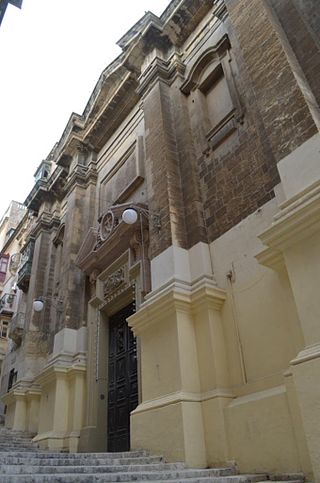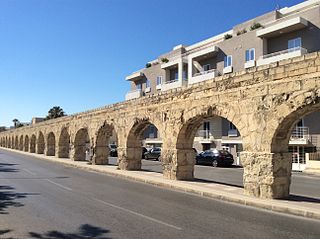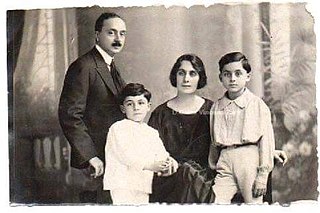
Valletta is an administrative unit and the capital of Malta. Located on the main island, between Marsamxett Harbour to the west and the Grand Harbour to the east, its population within administrative limits in 2014 was 6,444. According to the data from 2020 by Eurostat, the Functional Urban Area and metropolitan region covered the whole island and has a population of 480,134. Valletta is the southernmost capital of Europe, and at just 0.61 square kilometres (0.24 sq mi), it is the European Union's smallest capital city.

Floriana, also known by its title Borgo Vilhena, is a fortified town in the South Eastern Region area of Malta, just outside the capital city Valletta. It has a population of 2,205 as of March 2014. Floriana is the birthplace of many famous Maltese, amongst which the composer of the national anthem, 'L-Innu Malti', Robert Samut; former Bishop of Malta Dun Mauro Caruana, the poets Oliver Friggieri and Maria Grech Ganado, the writer and politician Herbert Ganado and Swedish Idol winner Kevin Borg.

The Tritons’ Fountain is a fountain located just outside the City Gate of Valletta, Malta. It consists of three bronze Tritons holding up a large basin, balanced on a concentric base built out of concrete and clad in 730 tons of travertine slabs. The fountain is one of Malta's most important Modernist landmarks.

The Valletta Waterfront, is a promenade in Floriana, Malta, mainly featuring three prominent buildings: a church in the middle, the Pinto Stores or the Pinto Wharf on the left, and the Forni Stores or the Forni Shopping Complex on the right. The buildings were originally stores and warehouses, built in the 18th century, and the design is attributed to Andrea Belli.

Carnival has had an important place on the Maltese cultural calendar for just under five centuries, having been celebrated since at least the mid-15th century. Carnival has been a prominent celebration in the Islands since the rule of Grand Master Piero de Ponte in 1535.

The Castellania, also known as the Castellania Palace, is a former courthouse and prison in Valletta, Malta that currently houses the country's health ministry. It was built by the Order of St. John between 1757 and 1760, on the site of an earlier courthouse which had been built in 1572.

The Franciscan Church of St Mary of Jesus is a church in Valletta, Malta, which is dedicated to St Mary of Jesus and is cared for by the religious order of Friars Minor. It came to be popularly known by the Maltese as Ta' Ġieżu. Ta' Ġieżu is a local corruption of Ta' Ġesù.

Republic Square is a piazza in Valletta, Malta. The square was originally called Piazza Tesoreria or Piazza dei Cavallieri, since the treasury of the Order of Saint John was located in the square. After a statue of Queen Victoria was installed in the square in the 19th century, it became known as Queen's Square or Piazza Regina. Although its official name is Republic Square, it is still commonly referred to as Piazza Regina.

The National Library of Malta, often known as the Bibliotheca, is a reference library in Republic Square, Valletta, Malta. It was founded by Grand Master Emmanuel de Rohan-Polduc in 1776 out of the collections of the knight Louis Guérin de Tencin. It has been a legal deposit library since 1925, and it has the largest collection of Melitensia along with that of the University of Malta. The library also contains the archives of the Order of St. John, the Università of Mdina and the Università of Valletta.

The Wignacourt Aqueduct is a 17th-century aqueduct in Malta, which was built by the Order of Saint John to carry water from springs in Dingli and Rabat to the newly built capital city Valletta. The aqueduct carried water through underground pipes and over arched viaducts across depressions in the ground.
Girolamo Cassar was a Maltese architect and military engineer. He was the resident engineer of the Order of St. John, and was admitted into the Order in 1567. He was involved in the construction of Valletta, initially as an assistant to Francesco Laparelli, before taking over the project himself. He designed many public, religious and private buildings in the new capital city, including Saint John's Co-Cathedral, the Grandmaster's Palace and the auberges. He was the father of Vittorio Cassar, another architect and engineer.

The Parliament House is the meeting place of the Parliament of Malta located in Valletta, Malta. The building was constructed between 2011 and 2015 to designs by Renzo Piano as part of the City Gate Project, which also included building a new City Gate and converting the ruins of the Royal Opera House into an open-air theatre. Construction of the Parliament House generated considerable controversy, mainly due to the modern design of the building and the cost of construction, which amounted to around €90 million.

The Saint Publius Parish Church, also known as the Floriana Parish Church is a Roman Catholic parish church in Floriana, Malta, dedicated to Saint Publius. It was constructed at several stages between the 18th and 20th centuries.

The Forni della Signoria was a bakehouse in Valletta, Malta. It was constructed in the late 16th century by the Order of St John, and it consisted of a number of bakeries which produced bread for the inhabitants of Valletta and the surrounding area, as well as for the Order's garrison and navy.

The Courts of Justice building is a courthouse located in Republic Street, Valletta, Malta. It was built in the neoclassical style between 1965 and 1971 on the site of Auberge d'Auvergne, which had been destroyed by aerial bombardment during World War II.

Gustavo Romeo Vincenti was a Maltese architect and developer. Born into a wealthy and business oriented family in Valletta and Floriana, he was able to purchase land and design and build buildings which he would then sell to clients. He was interested in architecture from a young age, and he graduated as an architect from the University of Malta in 1911, at the age of 23.

Gianni Vella was a Maltese artist. After studying in Rome, he produced many religious works which can be found in many churches in the Maltese Islands, but he also produced some secular works including landscape paintings, cartoons and a stamp design.

The remains of an unidentified Punic building exist incorporated into several properties in Żurrieq, Malta. They include a well-preserved structure commonly known as the Punic Tower or the Żurrieq Tower which is found inside the private garden of the Domus Curialis, the house of the town's archpriest, and which is the most substantial surviving example of Punic architecture on the island.


















